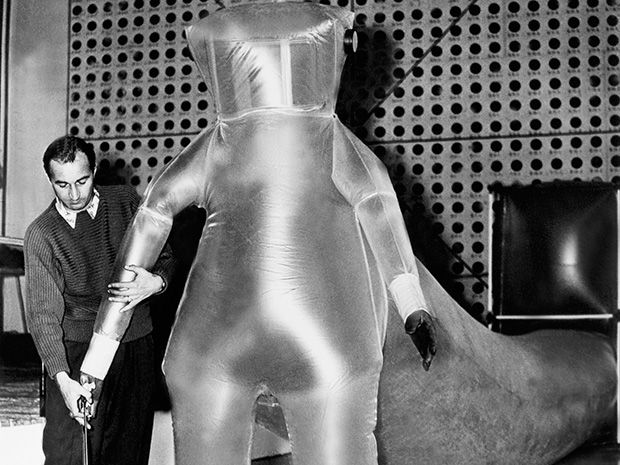For the Well-Dressed Atomic Worker, an Inflatable Suit
This “Atoms for Peace”-era polyethylene suit shielded nuclear power plant workers from radiation exposure
At an industrial exhibition to promote atomic energy in West Berlin in 1954, the U.S. government demonstrated an inflatable polyethylene suit, designed to shield workers in nuclear power plants from radiation. If it looks as though the suit also rendered the wearer invisible, that’s because there was nobody inside the suit when this photo was taken.
The suit’s inventor, Homer Moulthorp, patented this “method of conducting a person between a safe region and a dangerous region.” [pdf] Workers at a General Electric plutonium-processing plant in Richland, Wash., used the suit, but they still had to don a gas mask, gloves, and other protective wear while inside the inflated enclosure. To get into and out of the suit, they’d enter from a noncontaminated area and crawl through a tunnel that connected to the back.
Can a translucent plastic suit actually shield you from radiation? In fact, polyethylene offers more protection against radiation than, say, a comparable layer of aluminum. The main drawback is that it’s flammable, and at the thickness that would allow you to wear it, it can tear.
The grid of circles in the photo’s background, by the way, appears to be a mockup of the Brookhaven Graphite Research Reactor. It’s unclear why the U.S. Information Agency, which organized the Berlin exhibit, would have been promoting that particular reactor type, seeing as how the BGRR was designed to generate neutrons for scientific research, not electricity. In any event, when West Germany began constructing its first reactor four years later, it opted for a boiling water reactor.
This article appears in the June 2016 print issue as “Does This Make Me Look Fat?”
Part of a continuing series looking at old photographs that embrace the boundless potential of technology, with unintentionally hilarious effect.
Evan Ackerman is a senior editor at IEEE Spectrum. Since 2007, he has written over 6,000 articles on robotics and technology. He has a degree in Martian geology and is excellent at playing bagpipes.
